This week for Art Talk we are going to take a closer look one work of art.
Last month it was the King and Queen by Henry Moore. Today it will be The Burghers of Calais by Auguste Rodin.
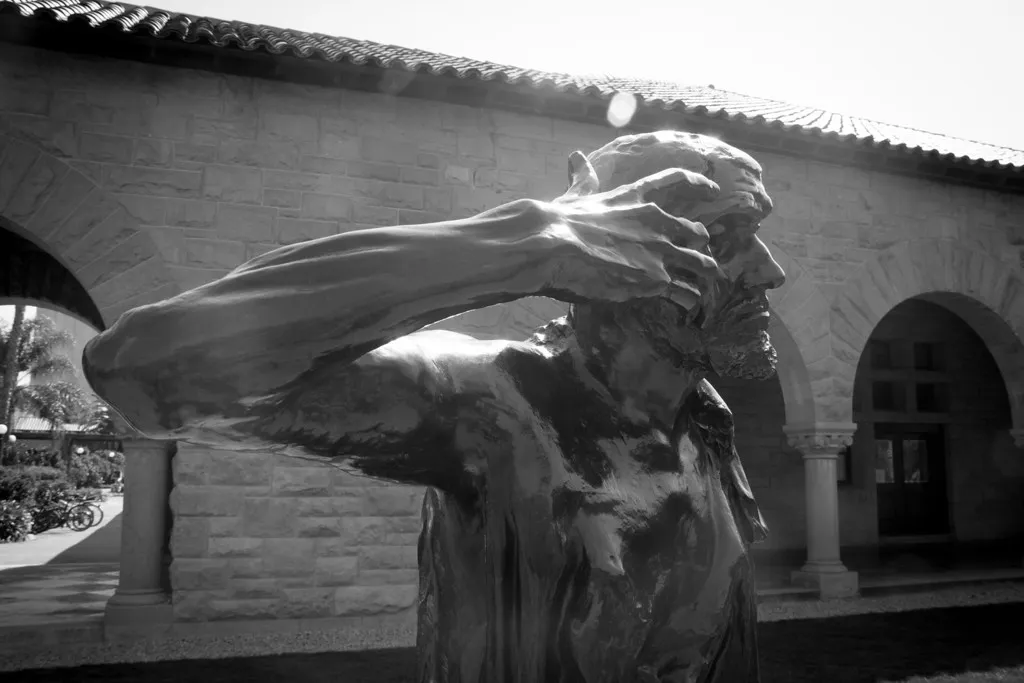
Detail of Jacques de Wissant
I will be using pictures I took of this incredible bronze at the MET in New York City, The Hirshorn Gallery Sculpture Garden in Washington, DC and Stanford University in Palo Alto, California and The book Naked Came I by David Weiss as the main sources for this post.
I will interweave the pictures and the story for a great visual and narrative story.

In my Emotion in Bronze post I did a couple of months ago @ErikaH suggested I read Naked Came I.
I read it and learned so much about Rodin and this sculpture in particular.

Let's start with a little bit of history of the story of the Burghers, or privileged citizen, of Calais, which is a port city in Northern France.
I will be sharing info from that book Naked Came I throughout this post.
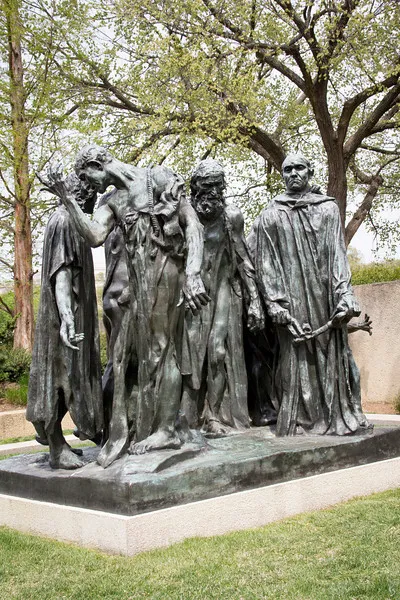
The Burghers of Calais, Auguste Rodin,
1884-1895
Hirshorn Sculpture Garden, Washington, DC
Auguste, after competing with many other sculptors, was chosen to execute a monument in honor of the heroic burghers of Calias who, in 1347, had given themselves up as hostages to Edward III of England to prevent, with their sacrifice, the massacre of the rest of the inhabitants of the besieged city.
After a heroic defense lasting nearly a year against the power of Edward III, lack of food had forced Calais to surrender. Then when the English king had threatened to raze the city and kill all the citizens, six of the burghers had offered themselves to Edward III, with nooses around their necks carrying the keys of Calais, as the price for the lives of their fellow citizens. 1

Now let's look at the sculpture as a whole.
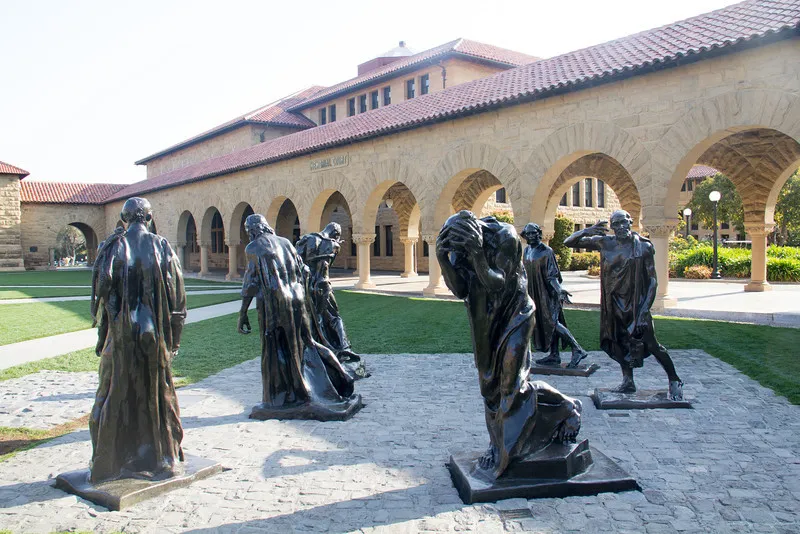
The Burghers of Calais, Auguste Rodin, 1884-1895
Stanford University, Palo Alto, California
As you can see from the picture above the statue contains six men.
Below is a conservation from the book Naked Came I between August Rodin, Camille Claudel (a sculptor, Rodin's assistant, muses and mistress) and Alfred Boucher (a sculptor and friend of both Camille and Rodin).
"It has to be six", said Auguste. "Six surrendered as hostages".
"But Calais asked for only one", insisted Boucher. "Eustache de Saint-Pierre, the leader and the most famous. I know Calais is unhappy about your decision to do six. The citizens say you are crazy the mad Rodin."
Auguste said stubbornly, "Froissart, the greatest historian of the age, said it was the act of six me, not one".
Camille said, "But six are so expensive, Auguste."
Auguste recited Froissart's description of the act: "The six burghers, bearheaded, their feet naked, with halters around their necks and the keys of the town and castle in their hands, said good-by to their loved ones, sure they would never see them again, shivering with fear, cold and anguish."
"Oh!" cried Boucher. "I agree it is touching. But not sensible."
Auguste brooded. "How can I compromise? The six burghers didn't."
Camille said, "But Calais is offering the same fee for six as for one."
"I know," Auguste said gloomily, "What Calais has offered for the entire project will barely cover the cost of one figure." 1
It took Rodin 11 years to complete this sculpture. As you can see from the conversation above he was committed to making the sculpture of each of the six men that Froissart described knowing it would take more time and money.
Having seen this sculpture many times and in different locations I can say that one of the reasons it is so powerful to me is that there are six men. It really makes a person ask, what is happening here? If there was one, as suggested, I think people would pass it up as a statue of someone famous. With six men with anguished expressions it makes one stop and study the painting and ask who are these people?

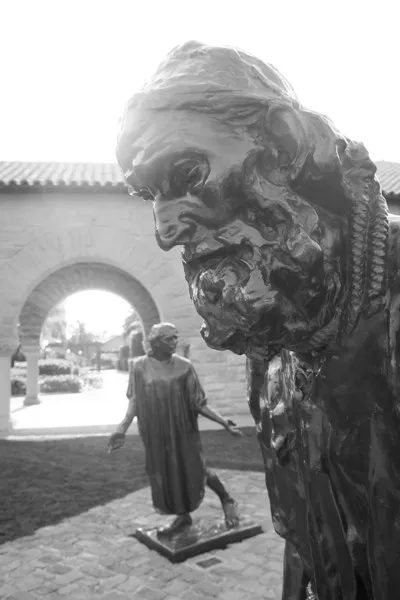
detail of Eustache de Saint-Pierre
Stanford University, Palo Alto, California
Eustache de Saint-Pierre is known as the leader of the group.
Showing the Burghers for the first time
In 1889, Auguste Rodin and Claude Monet had a joint exhibition at the Gorges Petit Gallery in Paris.
Monet showed seventy paintings and Rodin 36 sculptures including the Burghers of Calais, for the first time.
This exhibition coincided with the 1889 World's Fair in Paris and a few weeks prior the Eiffel Tower had been opened. The Eiffel Tower could be seen from the gallery.
Many famous people came to the exhibition including the President of the republic, Sadi Carnot, with Edward , Prince of Wales. Many of Rodin and Monet's friends also came including, Renior, Degas, Cezanne, Pissaro as well as famous writers such as Zola. 1

 |  |  |
|---|
Detail of Jean d'Aire


Detail of Jean de Fiennes
Stanford University, Palo Alto, California
Conversation with the President of France
During the evening Carnot, The President of the Republic, came over and admired the sculptures, he especially liked the engineering and the way they were grouped.
He reflected gratefully that none of the burghers were dangerously Republican or threateningly royalist, but in their anguish and courage simple Frenchmen who expressed what many felt yet could not say. He said softly, "How moving they are, Rodin, and so appropriate for the anniversary of the Revolution. Calais should be greatly pleased."
"Yes, Monsieur President. Calais hasn't even money for the casting and the erection of "The Burghers". 1

Initial reception by the public
Auguste felt better standing close to the plaster cast of "The Burgers," as if to protect them in their first public showing.
The gallery was full of voices whispering,
The Burghers' are decadent...
The Burghers' are ugly... 1

Detail of Andrieu d’Andres
Stanford University, Palo Alto, California

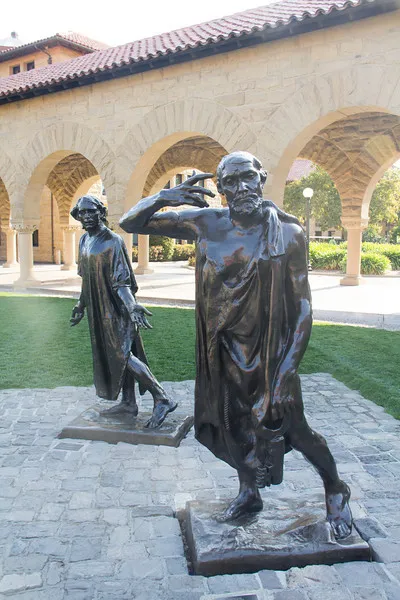
Detail of Jacques de Wissant
Stanford University, Palo Alto, California

Lottery
Ministry of the Interior was having a national lottery throughout all of France to raise 45,000 francs to cast the group in bronze and to erect it in Calais.
The lottery was a success. On June 3, 1895, almost ten years after "The Burghers" had been commissioned by Calais, they were dedicated there in a ceremony celebrated by the entire nation.
And Calais was treating him with respect. He had been made an honorary citizen of the city. 1

 |  |  |
|---|
Detail of Pierre de Wissant
Reception at the time of installation in Calais
The burghers were simple, plain men, men they understood and knew, as they knew themselves. Yet each Burgher was lonely and apart, each one gives life by his own particular breath and style, each cast in a mold different from the others. And as the crowd pressed closer, hushed and intent, the burghers became fellow citizens who had yeilded, yet not yeilded, who were suffering, yet would endure, who expected to be crucified, yet had come to hat of their own free will. 1

According the the Philadelphia Museum of Art, "The burgers were later spared thanks to the intervention of the English queen, who feared that their deaths would bring bad luck to her unborn child." 4
Hope you have enjoyed this in depth look at The Burghers of Calais and Rodin. Next week I will do a spotlight on Rodin and many of his works for art that I have seen and photographed through the years.
Sources
1 Naked Came I by David Weiss
2 MET collection:The Burghers of Calais
3 Khan Academy: Rodin, The Burghers of Calais
4 Philadelphia Museum of Art: The Burghers of Calais
Art Talk Series Highlights
Art Talk: Introduction has a link to all Art Talk posts
Art Talk: Emotion In Bronze
Art Talk: Moore in America
Art Talk: Art Tells Our Story
Art Talk: Highlight tour of the MET
